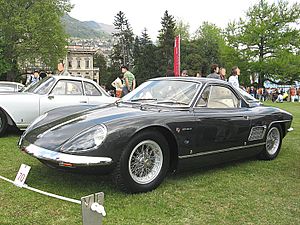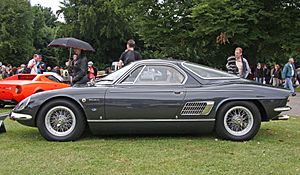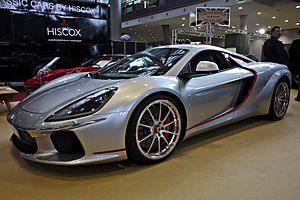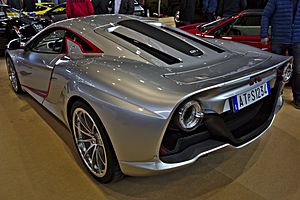Automobili Turismo e Sport facts for kids
 |
|
| Full name | Automobili Turismo e Sport S.p.A. |
|---|---|
| Base | |
| Founder(s) | Carlo Chiti Giotto Bizzarrini |
| Noted drivers | |
| Formula One World Championship career | |
| First entry | 1963 Belgian Grand Prix |
| Races entered | 5 |
| Constructors' Championships |
0 |
| Drivers' Championships |
0 |
| Race victories | 0 |
| Pole positions | 0 |
| Fastest laps | 0 |
| Final entry | 1963 Italian Grand Prix |
| Formula One World Championship career | |
|---|---|
| First entry | 1963 Belgian Grand Prix |
| Last entry | 1967 British Grand Prix |
| Races entered | 7 |
| Chassis | ATS, Derrington-Francis, Cooper |
| Constructors' Championships | 0 |
| Drivers' Championships |
0 |
| Race victories | 0 |
| Pole positions | 0 |
| Fastest laps | 0 |
ATS (which stands for Automobili Turismo e Sport) was an Italian company that made cars. It also had its own Formula One racing team. This team raced between 1963 and 1965. It was started by some talented people who used to work at the famous Ferrari car company.
Contents
Making Cool Cars: The ATS 2500 GT
The ATS company was created by Carlo Chiti and Giotto Bizzarrini. They wanted to build cars that could compete with Ferrari, both on the road and on the race track. With help from Count Giovanni Volpi, they designed a special sports car and a Formula One racing car. They showed these cars to the public in April 1963.
The sports car was called the ATS 2500 GT. It was a small, sleek coupé (a car with two doors and a sloped roof). Its body was designed by Franco Scaglione. The car had a powerful 2.5-liter V8 engine placed in the middle. This engine could produce 245 horsepower and reach speeds of 257 kilometers per hour (160 mph).
Only about 12 of these cars were ever built, so they are very rare today. The ATS 2500 GT was one of the first sports cars to have its engine in the middle. Even though it wasn't super famous, its V8 engine design was later used for the Alfa Romeo Tipo 33 engines.
Racing on the Track: The Formula One Story
ATS also built a Formula One car called the Tipo 100. Work on this car started in 1962. It was shown to the public in December 1962. The Tipo 100 had a very slim body. It was powered by a 1.5-liter V8 engine. This engine had special fuel injection and a 6-speed gearbox.
The ATS racing team had two drivers: Phil Hill and Giancarlo Baghetti. Both of them had previously raced for Ferrari.
Testing the car was difficult. If something broke, the car had to be taken back to Bologna for repairs. Then it had to be brought back to the track for more testing. One big problem was that the car's frame (chassis) was too flexible. They fixed this by welding extra tubes over the engine.
The ATS team planned to race early in the 1963 season, but the cars weren't ready. Their first race was at the 1963 Belgian Grand Prix. When the cars appeared, people were surprised. They looked messy, with dents and poor paint. The body panels didn't fit well. The extra tubes over the engine meant they had to be cut and re-welded for engine changes.
In their first two races, the 1963 Belgian Grand Prix and the 1963 Dutch Grand Prix, both ATS cars had to stop racing early. The team missed several races after that. The Tipo 100 returned for the 1963 Italian Grand Prix. In this race, both cars finished, but they were far behind the leaders. Phil Hill finished 11th and Giancarlo Baghetti finished 15th. This was the only race where an ATS car officially finished.
The team raced two more times in 1963, in the United States and Mexico. Both times, their cars had to retire early. After these races, ATS stopped being a Formula One team.
Later, an ATS car was used in a project called Derrington-Francis. This car raced once more in Formula One, at the 1964 Italian Grand Prix. It also had to stop racing early. This car was fixed up in the 1990s and now appears in old car races.
Count Volpi, who helped ATS, later supported another car company called Scuderia Serenissima. This company used some similar technology to ATS.
ATS Today: A Comeback Story
After ATS stopped making cars, its founders went on to do other things. Giotto Bizzarrini worked for Lamborghini and then started his own car company, Bizzarrini. Carlo Chiti started a company called Autodelta, which worked closely with Alfa Romeo for many years.
In 2017, the ATS name returned! A new car called the ATS GT was introduced. This modern sports car uses a powerful 3.8-liter twin-turbocharged V8 engine from McLaren. ATS plans to build only 12 of these new GT cars.
Complete Formula One World Championship results
(key)
| Year | Chassis | Engine | Tyres | Drivers | 1 | 2 | 3 | 4 | 5 | 6 | 7 | 8 | 9 | 10 | Points | WCC |
|---|---|---|---|---|---|---|---|---|---|---|---|---|---|---|---|---|
| 1963 | ATS 100 | ATS V8 | D | MON | BEL | NED | FRA | GBR | GER | ITA | USA | MEX | RSA | 0 | 18th | |
| Phil Hill | Ret | Ret | 11 | Ret | Ret | |||||||||||
| Giancarlo Baghetti | Ret | Ret | 15 | Ret | Ret | |||||||||||
|
|
||||||||||||||||
See also
 In Spanish: Automobili Turismo e Sport para niños
In Spanish: Automobili Turismo e Sport para niños





